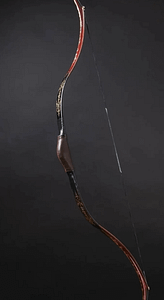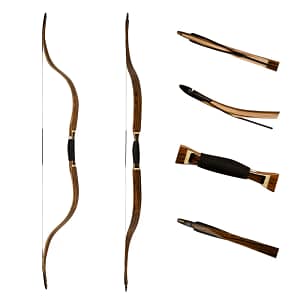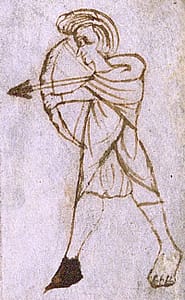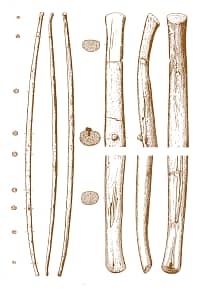Historical Archery: Asiatic Bows VS Traditional Longbows: Difference in Styles, Unique Features & Key Components
This post about historical archery explores the differences between longbows and Asiatic bows from the Middle Ages, highlighting their unique construction, usage, and historical significance.
With this comparison I am aiming to underscore the strategic advantages each type brought to historical warfare, and build an understanding of their significance on historic archery.
Introduction
Imagine, if you will, two men standing before you. They are wielding two different bows with two different sized arrows. They are preparing for a demonstration on how to shoot these historical bows. Although these bows originate from the middle-ages, they both come from entirely different regions, and are nothing alike.
You’ve always considered bows to be pretty straight forward – it’s a piece of wood with a string stretched between each end, right? Upon seeing these two side-by-side, you’re beginning to realise that there’s so much more to them than that.
The first man nocks a thick, heavy arrow to the first bow…
It is a magnificent English longbow crafted from European yew. This bow, adorned with a small leather wrap around the arrow pass, which aligns parallel with his upper chest. Towering above him at 6 feet 6 inches and weighing just under 1 kg (2.1 lbs), the longbow exudes a commanding presence.
Before he demonstrates the traditional shooting technique, he stands side-on to the target. Leaning into the draw, he uses three fingers to pull back the string. You notice that while being drawn, the bow flexes slightly – but its shape remains almost the same. The feather tickles his ear, signaling that he has reached full draw, and at that moment, he bends at the hip and locks on to his target, releases his fingers from the string, and sends the arrow flying effortlessly toward its mark with deadly force.
The second man walks forward, wielding a Turkish bow, along with a slender arrow...
Unlike the massive longbow the first man used, this bow is almost half the size, and the arrow is much skinnier and lighter. The archer explains that this bow has a maple wood core, reinforced with sinew and horn, and that this process creates a powerful bow with a stunning and compact appearance. As the archer prepares to demonstrate the historic archery technique used to shoot this bow, you notice he places a ring made from brass on his thumb.
The archer starts by nocking the slim, lightweight arrow to his bow. He wraps his thumb under the arrow and around the string, while crossing his index finger over his thumb, forming a T-figure. Facing the target at a slight angle, he leans forward and rotates at the hips, pulling back the string with his thumb and index finger while doing so.
As he draws the arrow, his shoulder muscles lock into place and the feathers brush against his cheek, signaling he has reached full draw. At this point his bow has flexed so much that it is almost unrecognisable.
He swiftly releases the arrow with a quick, yet smooth motion of his thumb and index finger, launching it toward the target at remarkable speed.
You’re now asked to make a decision: what bow do you think is more powerful?
The tall and sturdy English longbow, or the compact Turkish bow that seemed to flex so easily?
Many might assume that the tall, robust English longbow, used in both battlefields and hunting grounds, boasts more power. However, the compact, recurved design of composite Asiatic bows offers a powerful draw and an efficient energy transfer to the arrow, showcasing a unique and formidable approach to archery.
The meticulous construction of these two bows not only contributes to their strength and flexibility, but it also bolsters their abilities to transfer immense power from the bow to the arrow.
They are both powerful in their own right, but in what categories do each of these excel?
Join me on a journey into the world of historic archery, where we will examine four distinct types of longbows from the Middle Ages. We will aim to define their unique characteristics, find out what made them so prominent, discover why their popularity grew, locate where they were most used, and then compare them to Asiatic bows from the Steppe. Let’s begin!
Understanding other Types of Bows
People often assume that all bows in historical archery are essentially the same—a curved piece of wood with a string stretched between two ends, used to shoot arrows. However, in today’s modern age, we are fortunate to have access to a diverse range of bows from around the world. Our global connectivity, combined with a shared eagerness to exchange knowledge, provides us with unparalleled access to information about traditional & historic archery and the various bow types used throughout history.
To truly appreciate the unique characteristics of each style of bow, we must first select our subject and identify the period in which it was most prominent. By diving into the specific style, we can uncover the elements that make it distinct, and the resounding effect this caused.
What are Asiatic Bows?
Asiatic bows encompass a class of composite bows integral to various Asian cultures, known for their distinctive design and versatile use.
Their recurved shape enhances both compactness and power. Crafted from a blend of materials like wood, horn, and sinew, these bows excel in the hands of both mounted and foot archers.
Despite their relatively short length, Asiatic bows are capable of delivering a powerful shot with speed and precision.
Does learning about historical archery interest you?
You may enjoy reading my article about Turkish archery, history, and cuture.
Key Characteristics of Asiatic Bows
Composite Construction
- Made from multiple materials: Wood, Horn and Sinew
- Wooden core provides the basic structure
- Horn is used on the belly to enhance compressive strength
- Sinew is applied on the back to improve tensile strength
Recurved Shape
- The limbs curve away from the archer when unstrung
- This design increases the bows power and efficiency
- It also reduces the length of the bow while maintaining a long draw length
- This extreme recurved shape is unique to Asiatic bows within historic archery
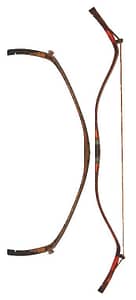
Shorter Length
- Typically shorter than western Longbows throughout history
- Easier to use from horseback or in confined spaces
- Easier to shoot more arrows-per-second due to maneuverability
Historical Use & Cultural Variations
- Widely used by nomadic cultures in Asia
- Integral to the success of cavalry archers due to their portability and high power
- Popular with the Mongols, Turks, Tatars, and various other tribes of the steppes.
- Different regions and cultures have their own unique adaptions
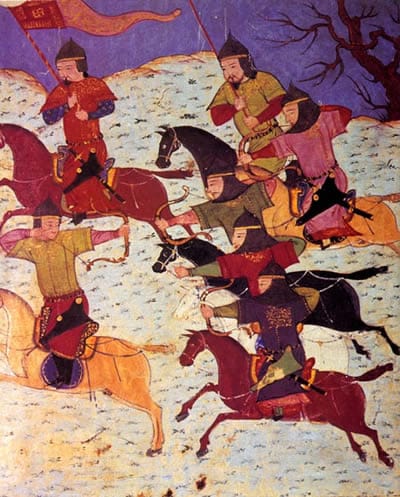
LONGBOWS
Longbows have played pivotal roles throughout history, from the powerful yew English and Welsh longbows of medieval times to the versatile American flatbow of the early 20th century and the rapid-shooting Scandinavian longbows of the Viking Age.
Most traditional longbows share common features: they are crafted from a single, long piece of wood, typically measuring between 5.5 and over 7 feet. The wood used for longbows must be strong, durable, and moderately flexible. When strung, longbows exhibit a slight curve, but when unstrung, they stand straight and tall.
The unique combination of the wood’s characteristics and the bow’s length allows for greater generation of kinetic energy, enhancing stability and accuracy for shooting over long distances.
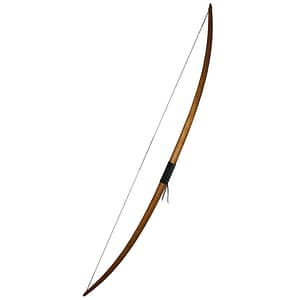
Traditional Sir Henry Strongbow
$389 @ ABA
While longbows may appear simple in design, they embody a complexity and depth comparable to composite bows. Archers carefully select materials, length, and structural details, making deliberate choices that have solidified the longbow’s status in the history of archery and warfare.
Let’s explore four types of longbows used throughout history and discover their unique characteristics!
English Longbow
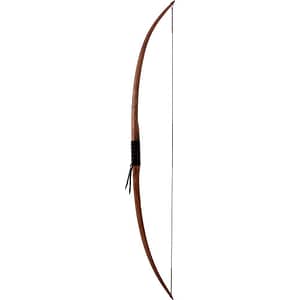
Traditional Star Longbow
By Bearpaw
Overview
- Period: 12th to 16th centuries
- Peak Use: The “Hundred Years’ War” (1337-1453)1
- Countries: England, Wales
- Unique: Bigger, more powerful, and a longer firing distance compared to its predecessors.
Distinct Elements:
- Length: 6 to 7 feet (1.8 to 2.1m)
- Draw Weight: 80-150#
- Materials: Yew Wood
- Design: Self-bow, no laminations
- Weight: 0.9 to 1.4kg (2-3 pounds)
The English longbow is a formidable weapon whose origins trace back to the early medieval period. This monster gained prominence during the 12th century and was capable of remaining a crucial element of English military strategy until the 16th century. Initially derived from the longbow used by the Welsh, the English longbow became a symbol of national pride and military prowess. This bow had been famously used in key battles such as Agincourt(1415), where the English archers’ longbows provided superior range and unstoppable power, which allowed for a decisive outcome against French forces. The effectiveness of the English longbow lay not only in its design but also in the skill of the archers who could shoot up to ten arrows per minute.2 3
Constructed primarily from yew wood, which was chosen for its exceptional strength and flexibility4, the English longbow could exceed six feet in length and had a draw weight often ranging between 80 to 150 pounds.5 6
This allowed for the high kinetic energy required to penetrate common types of armor used at the time, which led to the average archer being able to deliver lethal blows at considerable distances.
Its use extended beyond the battlefield, even influencing English law and culture. This was shown when King Edward III mandated that all able-bodied men were to undertake training with a bow, which further cemented the significance of the Longbow and ensured a steady supply of skilled archers.7 The English longbow’s prominence is not merely shown on the battlefield, but also in its profound impact on military tactics, social policy, and the very identity of England during the medieval era.8
The English Longbow remains one of the more recognisable bows to this day, and that should be of no surprise, as the impact it had on historic archery during the middle ages was significant.
Welsh Longbow
Overview
- Period: 12th to 14th centuries
- Peak Use: Medieval Wales
- Countries: Wales
- Unique: Simpler and more suited to rugged terrain
Distinct Elements
- Length: 5 to 6 feet (1.5 to 1.8m)
- Draw Weight: 60-100#
- Materials: Yew, Elm & Ash Wood
- Design: Self-bow, simple construction
- Weight: 0.7 to 1.1kg (1.5-2.5 pounds)
The Welsh longbow, a weapon of notable repute, has origins deeply embedded in the early medieval period, gaining significant prominence from the 12th century. Unlike the later English adaptation, the Welsh longbow maintained a unique identity and crucial role in Welsh defense and warfare until the late medieval period.10
This bow, distinct in its construction and usage, was renowned for its formidable power and range, which played a vital role in various conflicts, notably the battles during the Welsh struggles against English incursions.11
One of the most significant aspects of the Welsh longbow was the exceptional skill required to master its use. Welsh archers were known for their rigorous training, which began at a young age, and their ability to shoot a high number of arrows per minute—a critical advantage in both defensive and offensive engagements.12 The importance of archery in Welsh society was reflected in various laws and cultural practices, where proficiency with the bow was a valued skill, valued highly for the community’s defense.13
The Welsh longbow’s impact extended beyond mere military applications; it was deeply woven into the fabric of Welsh cultural identity and social practices.14 Its influence is seen in the Welsh legal traditions, where archery was not only a martial skill but also a communal obligation.15 The legacy of the Welsh longbow continues to be celebrated as a symbol of Welsh resilience and ingenuity, distinct from its English counterpart, and remains a subject of historical and cultural pride in Wales.16
Scandinavian Longbow
Overview
- Period: 8th to 11th centuries
- Countries: Scandinavia
- Unique: Shorter, optimized for rapid shooting and rugged use when compared to other European longbows
Distinct Elements
- Length: 5 to 6 feet (1.5 to 1.8m)
- Draw Weight: 60-80#
- Materials: Birch, Elm & Ash Wood
- Design: Simple, less curvature, suited for seafaring and rough terrain
- Weight: 0.9kg (2 pounds)
The Scandinavian longbow, particularly during the Viking era (8th to 11th centuries), is an essential yet often overlooked aspect of Norse military history. Similar to other Longbows on this list the Scandinavian Longbow’s design may appear straightforward, but once we delve into its impact and the craftsmanship involved, we discover a depth of historical significance. Viking bowyers were adept craftsmen who utilized the materials available in the Scandinavian region to create powerful and efficient longbows.17
Viking archers were integral to Norse raiding and military tactics, with the longbow playing a key role in their success. The longbow was not only a tool for hunting but also a primary weapon in Viking warfare, offering a tactical advantage in both naval and land-based combat. Viking sagas and historical accounts frequently mention the skill of Norse archers, who were trained from a young age to use the longbow effectively.18
The longbow proved to be a crucial asset during the Viking raids across Europe. It allowed for rapid, powerful attacks from a distance, providing an initial strike capability that often gave the Vikings an edge over their foes.
The longbow’s range and power were particularly advantageous in naval battles, where Viking ships, known for their speed and maneuverability, could engage enemies from a distance before closing in for melee combat.19
Scandinavian longbows have been used in many key historical conflicts.
At the Battle of Stamford Bridge (1066), 20 although it is more commonly known for ending the Viking age, longbowmen provided crucial support in the initial engagements.
In the Siege of Paris (885-886), 21 Viking forces employed longbowmen to relentlessly harass defenders in order to decisively control the battlefield.

The Siege of Paris (885-886)22
The legacy of the Scandinavian longbow extends beyond its military use. It is deeply woven into Norse culture and mythology, and symbolises the strength and skill of the Vikings. Norse sagas often depict legendary archers whose prowess with the longbow was a key to their heroism and success.
The tradition of archery continued in Scandinavia long after the Viking Age, influencing both hunting and military practices in the region.23 Today, the Viking longbow is celebrated in Scandinavian cultural heritage, with reenactments and historical studies keeping the legacy of these powerful weapons alive.
Traditional Flatbow (American Flatbow / Longbow)
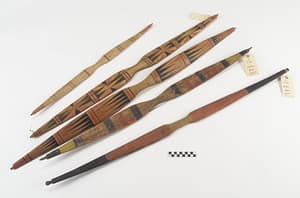
Native American Flatbows 24
Overview
- Period: Early 20th century
- Countries: United States
- Unique: Broader limbs, flat profile, and better stability than Native American bows
Distinct Elements
- Length: 5 to 6 feet (1.5 to 1.8m)
- Draw Weight: 30-70#
- Materials: Hickory, maple, laminates
- Design: Flat limb profile to distribute stress evenly
- Weight: 0.7 to 1.1kg (1.5-2.5 pounds)
Located in the diverse landscapes of the new world we will find a remarkable display of Native American history, the traditional American flatbow. This bow, similar to others on this list, stands out as a testament to the ingenuity and resourcefulness of the indigenous peoples of the area. Similar to the European longbows, the American flatbow is characterized by its simple yet effective design that has been perfected over centuries of use.
This bow’s straight limbs and flat, rectangular cross-section provided a combination of durability and power that made it a vital tool for survival and conflict across the diverse landscapes of North America.25
Flatbows were used extensively by various Native American tribes, ranging from the Great Plains to the forests of the eastern United States. They played a crucial role in hunting, allowing for the silent and effective taking down of game, which was essential for sustenance and survival.26 In warfare, the flatbow provided a tactical advantage with its accuracy and speed, enabling warriors to strike from a distance and remain agile on the battlefield.27 The bow’s simplicity in construction also meant that it could be produced relatively quickly and repaired with ease, a crucial factor in the harsh and unpredictable environments faced by Native American tribes.28
Historical Comparison: Longbows & Asiatic Bows
Despite its seemingly simple design, the longbow holds a significant place in history, offering surprising depth in its craftsmanship and impact. The master bowyers of the East were highly skilled artisans who perfected the use of composite materials in complex designs, primarily utilizing resources that were readily available in their regions. Similarly, the historical bowyers of England and Wales were adept craftsmen who refined their art to a high degree of excellence.
The Welsh laid the foundation for a bow design that would profoundly influence European history, a design later refined and perfected by the English. By focusing on the strengths of these bows while maintaining a straightforward design, they ensured that the crafting process allowed these bows to become widespread throughout England, ultimately cementing their place in archery and European history.
Unfortunately there are no direct historical sources that document battles where longbows and composite bows were the dominant bow for two armies pitted against each other. However, there are several notable conflicts where one side could have had longbowmen(W) within their army, and we know the other primarily employed composite or Asiatic bows(E).
These battles include:
- The Battle of Manzikert (1071)29
(W) Byzantine Empire vs. (E) Seljuk Empire - The Crusades (1096-1291)30 31 32
(W) Christian Armies vs. (E) Muslim Armies - The Battle of Varna (1444)33
(W) European Coalition vs. (E) Ottoman Empire - The Mongol Invasions of Europe (13th century)34
(W) European Nations vs. (E) Mongolian Empire - The Battle of Nicopolis (1396)35
(W) European Coalition (including English) vs. (E) Ottoman Empire

Painted bowl showing a Seljuk prince riding a horse, with a bow on his side.
Source: MET Museum, The Art of the Seljuqs36
While these two styles of bows were significant in their respective regions, one might wonder how they would compare to eachother directly on the battlefield. Perhaps if English longbowmen of the early 1400s, during the height of the Hundred Years’ War, faced off against steppe archers who had perfected the use of composite bows. Furthermore, what if these steppe archers were without their horses, facing each other in a direct archer-versus-archer conflict? Who would truly come out on top?
These are the things I often lay awake at night, pondering, and losing sleep over…
Shooting Speeds: Asiatic vs. Longbow
If we take a statistic such as “How many arrows can each shoot per minute?”, and then analyze the documented historical speeds at which each bow could fire at the enemy, we will immediately notice that the English Longbow was slower, shooting only 6 arrows per minute37, with a peak of around 10-12 arrows in short bursts.38
The Turkish archers in the Ottoman Empire however, were capable of shooting an average of 8 arrows p/m on foot, and 6 arrows p/m on horseback. Their speed in shorter bursts was a whopping 14-15 arrows p/m on foot, and 8-10 arrows p/m on horseback. This was in part due to the use of thumb rings, and their ability to hold 6 or more arrows in their bow hand while shooting.
Conclusion
In the opinion of an archery enthusiast who enjoys research and thought exercises, distinct advantages are offered by both Traditional Longbows and Asiatic Bows, which have been shaped by their historical contexts. The design principles, versatility, efficient energy transfer, and formidable power of Asiatic bows are celebrated, often leading them to outshine longbows in practical applications.
Asiatic Bows also excel in compactness and maneuverability, which allows specialized techniques like mounted archery and skirmishing to excel far beyond what traditional longbows are able to achieve. These traits, paired with the skill of eastern archers, allowed them to shoot with speeds unseen in the west. Pairing their specialized techniques for warfare, and the speed of which they could shoot, meant that their role in eastern warfare was crucial in both historical and semi-modern combat scenarios.
On the other hand, longbows are renowned for their unmatched power and deep historical roots. However, their cumbersome size, limited maneuverability, and greater skill demands for effective use can constrain their versatility in diverse tactical situations. A volley of arrows sent from a regiment of English Longbowmen may have been deadly, and I can say with 100% certainty that I would not willingly put myself on the opposite side of the battlefield.
In Favour of Longbows
- Penetration & power is superior at longer ranges
- Simple Self-Bow Design
- Durabiity & Weather Resistance
- Easier to Learn / Master
- Easier to Produce
- Superior for Open-Field Engagements
In Favour of Asiatic Bows
- Ability to shoot more arrows per minute
- Faster arrow flight & more powerful at short range
- Compact Size & Maneuverability
- Dominant at all ranges
- Deadly When Combined with Mounted Archery
- Flexibility for Different Shooting Styles
Ultimately, the choice between these iconic bow styles hinges on specific needs and preferences. Each offers unique strengths that contribute to their enduring legacy in the realms of archery and historical warfare, ensuring they remain pivotal instruments in the study and practice of ancient and modern combat strategies alike.
A note from the author
I hope you enjoyed this look into the history of Longbows and their comparison with Asiatic bows. I am a little biased in my love for Asiatic bows, however I am also fascinated by Medieval warfare and historical archery, so I hope I have been able to do this topic justice.
If you believe I got something wrong, or want to suggest a change, please don’t hesitate to comment or reach out! I am always happy to improve my understanding of the topics I’m passionate about, and challenge my own personal biases. If you can provide any sources you believe are relevant or informative, include those too!
Thank you for joining me, and I hope you’ll be here for my next article, where we’ll further explore Asiatic archery and learn about the types of traditional arrows various Steppe cultures used.
- Robert Hardy, Longbow: A Social and Military History (Sutton Publishing, 2006) ↩︎
- Wikipedia Contributors, Longbow (Wikipedia, The Free Encyclopedia, 2024) ↩︎
- Robert Hardy and Matthew Strickland, The Great Warbow: From Hastings to the Mary Rose (Sutton Publishing, 2005) ↩︎
- Clifford Rogers, The Oxford Encyclopedia of Medieval Warfare and Military Technology (Oxford University Press, 2010) ↩︎
- Longbow: A Social and Military History (n 1) ↩︎
- David Loades, The Tudor Navy: An Administrative, Political and Military History (Routledge, 1992) ↩︎
- Wikipedia Contributors, History of Archery (Wikipedia, The Free Encyclopedia, 2024) ↩︎
- Longbow: A Social and Military History (n 1) ↩︎
- Wikipedia Contributors, Welsh Bows (Wikipedia, The Free Encyclopedia, 2024) ↩︎
- David J. Cathcart King, Castellarium Anglicanum: An Index and Bibliography of the Castles in England, Wales and the Islands (Kraus International Publications, 1991) ↩︎
- Robert Rees Davies, The Revolt of Owain Glyn Dŵr (Oxford University Press, 1995) ↩︎
- Robert Rees Davies, The Age of Conquest: Wales 1063-1415 (Oxford University Press, 2000) ↩︎
- Arthur Herbert Dodd, Life in Wales (University of Wales Press, 1951) ↩︎
- John Davies, A History of Wales (Penguin Books, 2007) ↩︎
- Ralph A. Griffiths, The Principality of Wales in the Later Middle Ages: The Structure and Personnel of Government: South Wales 1277-1536 (University of Wales Press, 2018) ↩︎
- Kenneth Bruce McFarlane, England in the Fifteenth Century: Collected Essays (Bloomsbury Publishing, 1981) ↩︎
- Else Roesdahl, The Vikings (Penguin, 2016) ↩︎
- William R. Short, Viking Weapons and Combat Techniques (Westholme, 2008) ↩︎
- Jane Kershaw, Viking Identities: Scandinavian Jewellery in England (Oxford University Press, 2013) ↩︎
- Michael C. Blundell, The Battle of Stamford Bridge: The Reliability of the Accounts in the Kings’ Sagas (Scandinavian Studies, 2024) ↩︎
- R. I. Page, Chronicles of the Vikings: Records, Memorials, and Myths (The British Museum Press, 2014) ↩︎
- Wikipedia Contributors, The Siege of Paris [885-886] (“Wikipedia, The Free Encyclopedia”, 2024) ↩︎
- Gwyn Jones, A History of the Vikings (Oxford University Press, 1968) ↩︎
- National Museum of the American Indian (Smithsonian Institution, 2024) ↩︎
- Jim Hamm, Bows & Arrows of the Native Americans: A Step-by-Step Guide to Wooden Bows, Sinew-backed Bows, Composite Bows, Strings, Arrows & Quivers (The Lyons Press, 2007) ↩︎
- George Bird Grinnell and Joseph A. Fitzgerald, The Cheyenne Indians: Their History and Lifeways (World Wisdom, 2008) ↩︎
- Carl Waldman, Encyclopedia of Native American Tribes (Infobase Publishing, 2014) ↩︎
- John Canfield Ewers, Indian Life on the Upper Missouri (University of Oklahoma Press, 1968) ↩︎
- John Julius Norwich, Byzantium: The Apogee (Viking, 1991) ↩︎
- Steve Runciman, A History of the Crusades: Vol 1 (Cambridge University Press, 1987) ↩︎
- Terence Wise, Armies of the Crusades (Bloomsbury USA, 1978) ↩︎
- Wikipedia Contributors, The Crusades (Wikipedia, The Free Encyclopedia, 2024) ↩︎
- Warren T. Treadgold, A History of the Byzantine State and Society (Stanford University Press, 1997) ↩︎
- Stephen Turnbull, Genghis Khan & the Mongol Conquests 1190-1400 (Bloomsbury Publishing, 2014) ↩︎
- Wikipedia Contributors, Battle of Nicopolis (Wikipedia, The Free Encyclopedia, 2024) ↩︎
- Suzan Yalman and Linda Komaroff, “The Art of the Seljuqs of Iran [ca. 1040-1157] (MET Museum Department of Education, 2001-2002) ↩︎
- The Great Warbow (n 3) ↩︎
- Michael Prestwich, Armies & Warfare in the Middle Ages: The Experience of War in England: The English Experience (Yale University Press, 1999) ↩︎
